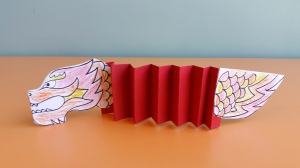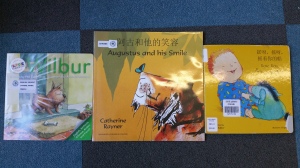Activity 3: Attend bi-lingual story time at local public library
Topic: Diversity
To explore the topic of diversity in public libraries, I attended a bi-lingual story time for pre-schoolers at Wallsend District Library in Newcastle.
The session was held in the children’s section and was facilitated by a staff member and a volunteer parent. The story time session involved songs and stories incorporating Mandarin and English, and also a craft activity to make a paper dragon (see the Appendix for more details). This session was attended by 15 families.


What did I learn?
The structure of the session was similar to other story times I have attended, with the second language incorporated into the stories and songs. I had not previously explored the bi-lingual collection, which at Wallsend District Library is quite small. The librarian explained that to supplement the items available, the library had a selection of bi-lingual books borrowed from the State Library of NSW for members to borrow. I discovered that to run the sessions, the library staff seek assistance from members of the community with a second language. Therefore, I learnt that the bi-lingual sessions require additional planning due to the requirement to source books and organise language volunteers.
How was the activity relevant to my professional practice as a librarian for children?
Bi-lingual story time is a valuable program for inviting children into the library from different cultures. The bi-lingual sessions provide an opportunity for children to be involved in their own language and feel welcome in the library. The session also facilitates social interaction between families from similar backgrounds and to meet other families using the library.
ALIA’s “Statement on public library services” states that public libraries are to provide services “to actively contribute to the social inclusion for all members of the Australian community”. Accordingly, children’s librarians have a responsibility to assist and support those from different cultural backgrounds. Bi-lingual story time is a positive program aimed at fulfilling this responsibility to the youngest members of our community and their families.
Were any gaps in my knowledge revealed? How might I fill those gaps?
As explained above, I am now aware of the organisation requirements for bi-lingual story time. I think it would be beneficial to attended a similar session in another library outside of Newcastle to gain further insight into how the programs are run and if there are any differences depending on the language and culture.
Topic: Diversity
The benefits of bi-lingual story time include supporting literacy and numeracy, encouraging parents to sing and read, recognition of the importance of maintaining a child’s first language, and facilitating “social inclusion” (Alakus, 2009, p.27). Bi-lingual story time demonstrates to children that their culture is important (Alakus, 2009, p.27).
I had assumed that bi-lingual story time sessions were specifically for those with English as a second language. However, these sessions not only support families who speak another language, they also introduce other children to different cultures (Steed, 2011, p.116). What this demonstrates is that to truly embrace diversity, rather than segregating the community and holding exclusive events, libraries should hold events to meet particular needs that are inclusive of everyone in the community.
References
Alakus, R. (2009). A fun way to connect with the community. inCite. 30(4), 27-28.
Australian Library and Information Association (ALIA). (2009). Statement on public library services. Retrieved from: https://www.alia.org.au/about-alia/policies-standards-and- guidelines/statement-public-library-services
Steed, S. (2001). Australian Capital Territory. In Public libraries serving multicultural communities across Australia: Best practice examples. Aplis, 24(3), 116-124.
Appendix
The session opened with the group invited to sing “If you’re happy and you know it…” with this repeating line sung in English and the action part of the song in Mandarin. Three picture books were then read by the librarian and volunteer. The librarian read the words on each page in English and then the volunteer read the translation. The children were very engaged with the books. The final song was “Twinkle twinkle little star” sung through in English and then in Mandarin. The craft activity was making a paper dragon.

Hi Catherine! This sounds like a fantastic program, what a simple, but creative idea. I’ve not heard of any public libraries in my area running a story time program like this, which is a little disappointing, as I live in quite a culturally diverse area.
I can see so many benefits in running this type of program, many of which you have addressed in your evaluation. Such as the importance of supporting children in retaining their first language, fostering a sense of inclusion and support within the community for people from all cultural backgrounds, and introducing children to different cultures.
It seems as though this was a valuable experience for you, particularly with regard to the gaining a good comprehension of the organizational side of things, such as sourcing the materials in Mandarin, and working with community volunteers. This kind of information is always incredibly valuable professionally, so that you very much for sharing your experience!
LikeLike
Thanks Elizabeth, I really enjoyed observing the event, and in particular as you mentioned how it benefits the whole community not just those families where English is an additional language.
LikeLike